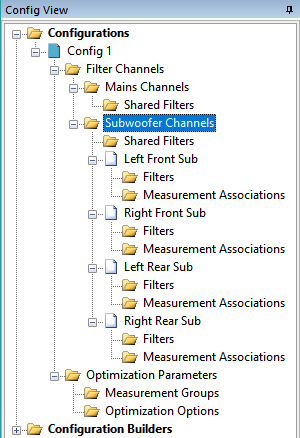Defining Filter Channels
The Assumed DSP Channel Structure
MSO does not maintain a database of different DSP hardware implementations or capabilities. Instead, it's assumed the DSP used for the subs has a single input (driven from the AVR or pre-pro's sub out) and multiple outputs. The input is assumed to have an optional bank of IIR filters whose response affects all channels at once (called the "Shared Filters" in MSO, and "input filters" in miniDSP parlance). After the optional input filters, the signal is assumed to split up into multiple output channels, with a bank of IIR filters in each output channel.
There is no limit (other than optimization time) on the number of output channels, and thus the number of subs to be optimized. To accommodate this capability, it's necessary for you to add the required number of subwoofer channels (and main speaker channels as applicable) to the configurations you create. This is done automatically when you use the Configuration Wizard. The following instructions describe the process of how to add these channels manually if you aren't using the Configuration Wizard.
Adding Filter Channels
First, ensure that the required configuration has been created. This is done by following the procedure for creating an empty configuration.
To add subwoofer channels, select the Config View tab. You'll see the initially empty configuration you just created. Right-click the Subwoofer Channels node and choose Add Filter Channel from the context menu as shown below.

This will create a new channel initially named "Sub Channel 1". Repeat this operation as many times as needed so that the number of sub channels in MSO matches the number of DSP channels you're using for your subs. It's useful to rename these channels to match up with your own unique situation. To do that, select the channel and press F2. An edit control will appear, allowing you to edit the channel name in place. An example of a configuration with renamed channels is shown below.

If you are using a subs+mains configuration, you'll also need to create one or more main speaker channels, even if you are not doing any DSP of the main channels. The number of main channels you create should be the same as the number of main speakers you have measured independently. This is usually either one or two: one if you measured only the center channel, or two if you measured the left and right main channels individually.
Now that you've created your filter channels, you can add filters to them. That step is shown next.